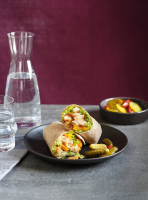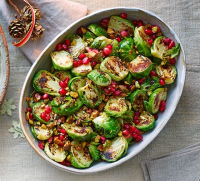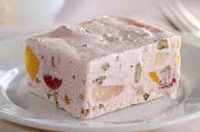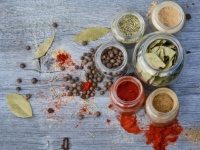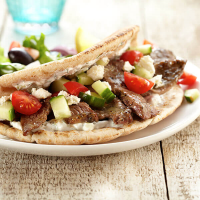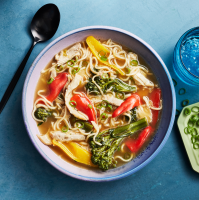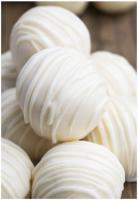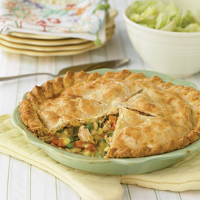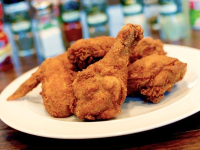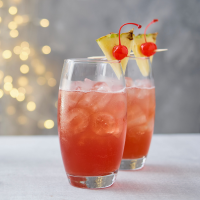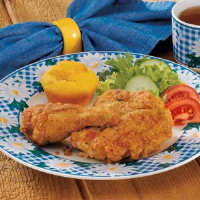PASTELES RECIPE - FOOD.COM

In Puerto Rico, these wrapped goodies are made in large quantities during the holidays, often with several family members sharing in the tasks of preparation. A food processor or blender makes the job easier. There are different versions. This one has a lot of ingredients but it is still very good. You can also stuff them with chicken instead of pork. (Time to make depends on how much help you can get!)
Total Time 5 hours 10 minutes
Prep Time 4 hours
Cook Time 1 hours 10 minutes
Yield 16-20 Pasteles
Number Of Ingredients 23
Steps:
- add oil in a large skillet over medium heat. Add the annatto seeds and heat for one minute to release their orange color.
- Remove from heat and drain the oil into a separate container.
- Discard the seeds and return half of the oil to the skillet.
- Return the oil to medium-high heat and add the pork and bacon. Brown for about 5 minutes, stirring occasionally.
- Add the garlic, onion, bell pepper, small green peppers, tomatoes, culantro, and oregano, and sauté for another 5 minutes.
- Stir in the chickpeas and olives (with their respective liquids), capers, and raisins.
- Cover and simmer over low-medium heat for 40 minutes. When done, uncover and allow to cool.
- Drain the broth into a separate container and set aside.
- Make the dough by peeling the plantains and the bananas, first cutting off the ends and running a knife tip lengthwise along one or more of the ridges.
- Insert and run a thumb just beneath the cut peel to lift and remove it. Peel the yautia.
- Place plantains, bananas, and yautia into a large bowl of salted cold water to prevent discoloring.
- You can grate them using the fine side of a hand grater, or instead, cut into 1/2- to 1-inch pieces for the processor.
- Fill 1/3 to 1/2 of the food processor or blender container with the cut vegetables, slowly adding broth to form a smooth, porridgelike mash. It should not be runny.
- Transfer the purée to a large bowl. If you run out of broth, substitute water as needed.
- Stir in the salt and the remaining annatto oil.
- Place a banana leaf on a sheet of parchment paper.
- Drop a scant 1/2 cup of the dough onto the center of the leaf and spread it several inches all around with the back of a spoon.
- Drop 2 tablespoons of the filling a bit off center. Fold each long side and then the ends toward the center.
- Slide the encased leaf toward the long edge of the parchment and wrap again.
- Fold end flaps over.
- Tie two pasteles together, with folded edges facing each other.
- To cook, put a batch (4 to 6 tied bundles) into a large kettle of salted boiling water and cook semicovered at medium-high heat for 30 minutes.
- Turn the bundles over and cook 40 minutes more.
- When done, drain them well, remove the strings and wrappings, and serve hot.
Nutrition Facts : Calories 251.8, FatContent 9.8, SaturatedFatContent 3.5, CholesterolContent 31.2, SodiumContent 629.1, CarbohydrateContent 31.3, FiberContent 3.1, SugarContent 15.7, ProteinContent 11.8
PASTELES RECIPE - NYT COOKING

Most of the components for pasteles, a traditional Puerto Rican holiday dish, can be made a day or two in advance, then brought to room temperature for assembly. You can prepare the masa ahead, and freeze it for up to several months. Pasteles can also be cooked right away, refrigerated for a few days or frozen in zip-top containers for several months. Some use only green bananas or green plantains – which are unripe, firm and very green – for the masa; some add potatoes or pumpkin; some add yuca, also known as cassava, and others use only yuca. If you can’t find one or more ingredients, use what you can find. Lucy Ramirez adds pork gravy to the masa (other cooks may add milk or oil) and makes sure there’s a little pork in every bite of the pastel. Traditionally, pasteles were fully wrapped in banana or plantain leaves before being wrapped in parchment paper or foil. Today, many cooks use a piece or strip of banana leaf to give each pastel the nutty flavor of the leaf. Serve them with a side of hot sauce or ketchup. Click here to learn how to assemble the pasteles.
Provided by Rachel Wharton
Total Time 4 hours
Yield 36 pasteles, or 18 pairs
Number Of Ingredients 23
Steps:
- Make the sofrito: Place the chiles, bell peppers, onions, culantro, cilantro, garlic and pimentos in a blender and process until the mixture is fully puréed, scraping the sides of the blender as needed. Refrigerate until ready to use: This can be made up to 3 days in advance and refrigerated.
- Make the masa: Peel the bananas and plantains: Prepare a mixing bowl or large pot with water. Cut off the ends of the fruits, then use a knife to score and peel off the skin. Place the bananas in the bowl of water as you go so they don’t discolor. (The skins can stain, so be careful as you handle them, or wear plastic gloves.) Remove the skin of the yautia with a vegetable peeler and add it to the water.
- Remove the bananas, plantains and yautia from the water and process until smooth: First, in a food processor fitted with the grating disc, shred each ingredient separately, dumping them into a large bowl as you go. Mix the ingredients together in the bowl, switch to the blade fitting, and process the mixture in batches until smooth, stopping to scrape down the sides of the work bowl as necessary. The end result should look soft and fluffy like a purée. (Alternatively, you can grate everything by hand on the smallest holes of a box grater.) Transfer the masa to a large mixing bowl. At this point it can be refrigerated for a few hours, covered, while you prepare the pork, or frozen for up to 3 months.
- Prepare the pork: Cut the pork into small, rough chunks about 1 inch long by 1/2 inch wide, trimming away excess tough fat as you go. Place the pork pieces in a large stockpot or Dutch oven over medium-high heat. Stir in the reserved sofrito, making sure all of the pork cubes are coated. Let the pork cook, stirring almost constantly, until it starts to release some liquid, about 5 minutes. Add the olive oil and let it cook for a minute or two, then stir in the seasoning packet.
- Let the pork cook for another minute or two, then stir in the olives and their brine, the tomato sauce and the chicken stock or water, and a pinch of salt. Let the liquid come up to a simmer, then cover the pot and reduce the heat. Let the pork cook at a simmer for 30 minutes, or until the meat is cooked through, stirring occasionally. There should be plenty of liquid in the pot at all times, so the mixture looks like soup, not stew. If it looks dry, add stock or water as needed.
- While the pork cooks, make the annatto oil: In a small saucepan, heat the oil and the annatto seeds over medium-high heat, stirring occasionally, until the oil begins to bubble. Lower the heat slightly and let the seeds cook in the oil until the liquid turns a bright pink-red. Turn off the heat and let the seeds sit in the oil until it cools. Strain the oil through a sieve or slotted spoon into a small mixing bowl, discarding the seeds. Set the bowl aside. (If the liquid does not immediately begin to turn red, your annatto seeds are too old.)
- When the pork is done, taste for seasoning, and add more salt if desired, then turn off the heat. Take 2 to 3 cups of the liquid from the pork and stir it into the masa until it is the consistency of thick oatmeal, soft but spreadable. You will still need about 2 to 3 cups of liquid to make the pasteles, so if your pot looks dry at this point, stir in a little water or stock so that you still have plenty of liquid, and taste for seasoning again.
- On a large, clean work surface, set up your pastel-making station: You will need the banana leaves, parchment paper, string, the annatto oil, the pork and its liquid, and the masa. To make each pastel, start with a piece of parchment paper in front of you, one long side closest to you. Use a soup spoon or a pastry brush to paint a very thin smear of annatto oil on the parchment paper, leaving a 2-inch border on the top and bottom and 4 inches on the sides. (This does not have to be perfect: It’s just to keep the banana leaf from sticking.) Lay the banana leaf down on top of the oil, long side closest to you. Paint the banana leaf very lightly with the annatto oil. Spread 1/2 cup of masa on top of the banana leaf about 3/4 to 1/2 inch thick. The masa does not have to be a perfect shape: It can overlap the leaf in places and does not have to cover it completely.
- Spoon a scant 1/4 cup of pork pieces along the length of the masa in a straight line. Your goal is really a line of pork chunks along the center of the masa, so that each bite of pastel has a bite of pork. Add 2 olives to the masa, one near each end. Use a spoon to drizzle on a little more liquid as needed so that most of the masa is covered by a very thin layer of liquid. Don’t overdo it: About a tablespoon or so of liquid per pastel is about right.
- To form the pastel, fold the parchment paper in half, from the bottom up, over the masa and filling so the 2 long edges meet. Fold those edges down to meet the edge of the pastel farthest from you. Press the paper down and crease the top edge. Fold the parchment in half again lengthwise from the top down, so it covers the pastel. You now have a long thin pastel wrapped in a tube of parchment, with multiple layers of paper on top. (This needn't be exact, as long as the paper forms a neat little package.)
- Working carefully, use the side of your hand to press and slide the masa on either side of the package into the center to give it a neat edge. Fold in 1 inch of the paper on the left and right sides to create small hems. Then fold both sides over the pastel. (If you have a few leaks, it’s O.K.)
- Set this pastel aside, flaps facing downward, while you make its partner: Repeat the process above to make a second pastel.
- When you have 2 pasteles, stack them together so they line up, flaps facing inward. Use 1 piece of string to tie the pasteles together the same way you would a package, looping the string once across the long way and at least once across the short way. Make sure the string is tight and the pasteles are tightly tied together. Repeat this process with the remaining pairs of pasteles. At this point they can be frozen for several months, refrigerated for a day or two, or cooked and eaten immediately.
- To cook them, bring a large pot (or a few pots) of salted water to a boil and add the pasteles, either fresh or frozen, in a single layer. Let cook for 1 hour, or an hour and 10 minutes or so if they are frozen. Repeat with the remaining pasteles, then unwrap and serve right away.
More about "pastel foods recipes"
PASTEL DE CHOCLO RECIPE | ALLRECIPES
Choclo is the quechua word for "tender corn," or the new corn of the season. This is a typical Chilean dish, but is also eaten in Argentina and Peru with some variations in the recipe, sometimes using cornmeal instead of freshly mashed sweet corn. Serve with Chilean salad and/or pebre.
From allrecipes.com
Total Time 1 hours 15 minutes
Category World Cuisine, Latin American, South American, Chilean
Cuisine Latin American, South American, Chilean
Calories 434.6 calories per serving
From allrecipes.com
Total Time 1 hours 15 minutes
Category World Cuisine, Latin American, South American, Chilean
Cuisine Latin American, South American, Chilean
Calories 434.6 calories per serving
- Bake in the preheated oven until golden brown on top, about 20 minutes.
See details
TRADITIONAL PUERTO RICAN PASTELES RECIPE
Dec 09, 2006 · Wrap the Pasteles Prepare a work surface to assemble and wrap the pasteles. If you have friends helping you, set up an assembly line. For each pastel, lay out a piece of parchment paper, topped with 1 piece of banana leaf. Brush achiote oil in a... Spread 1 1/2 to 2 spoonfuls of masa onto the center ...
From thespruceeats.com
From thespruceeats.com
See details
COLORS AND TASTES OF SPRING: 15 AWESOME PASTEL COLORED ...
From wonderfuldiy.com
See details
HOW TO MAKE PUERTO RICAN PASTELES FOR CHRISTMAS | ALLRECIPES
Dec 02, 2020 · Stuffing the pasteles: Cut parchment paper into 12x12-inch or 12x18-inch pieces (if not using pre-cut pastel wrappers). Rub a little achiote... Place ¾ cup of the masa on top of the leaf and spread to approximately cover the leaf leaving a small indentation in the... Place ¼ cup of the picadillo in ...
From allrecipes.com
From allrecipes.com
See details
BRAZILIAN PASTEL - 3 FILLINGS - OLIVIA'S CUISINE
Jul 13, 2018 · Pastel Dough: 3 cups all purpose flour, plus more for dusting 1 tablespoon salt, or to taste 1 cup warm water 1 tablespoon vegetable oil 1 tablespoon white wine vinegar 1 tablespoon cachaça Vegetable oil for frying
From oliviascuisine.com
From oliviascuisine.com
See details
8 PASTEL-COLORED FOODS TO MAKE THIS SPRING
From spoonuniversity.com
See details
PASTELES RECIPE (PUERTO RICAN SAVORY CAKES IN BANANA ...
Bring a large pot of well salted water to boil on the stove. Drop in the prepared pasteles and boil gently for 1 to 1 1/2 hours. Remove from the water with tongs, remove the outer parchment and serve the pasteles with or without their banana leaf wrapping. Goes well with arroz con gandules.
From whats4eats.com
From whats4eats.com
See details
PASTEL (SEPHARDIC MEAT PIE) RECIPE | THE NOSHER
From myjewishlearning.com
See details
PASTEL FOOD - COOKEATSHARE
Recipes / Pastel food (1000+) Holiday Angel Food Cake. 11163 views. Holiday Angel Food Cake, ingredients: 1 angel food cake, 1 (20 ounce.) can crushed. Diet Strawberry Angel Food Cake. 11424 views. strawberry jello, Cool Whip, lite, 1 angel food cake, 1 pkg. frozen strawberries, plain or.
From m.cookeatshare.com
From m.cookeatshare.com
See details
PASTEL (SEPHARDIC MEAT PIE) RECIPE | THE NOSHER
Mar 01, 2021 · To make the pastel, b eat 2 of the eggs in a large bowl, add the cooled seasoned beef, and mix to blend. Set aside. Press one of the puff pastry sheets onto the bottom and up the sides of a 9-by-11-inch baking dish. Spoon the beef-egg mixture into the dish and sprinkle with the parsley and dill. Lay the remaining sheet of puff pastry on top ...
From myjewishlearning.com
From myjewishlearning.com
See details
HOW TO MAKE PASTELES RECIPE HAWAII - BEST COOK IDEAS
May 15, 2017 · Grind garlic clove and spices together and stir into pan. Cover and prepare over medium heat half an hour. In a tiny saucepan, combine oil, broth, onion and parsley and produce to some boil. Stir into pork mixture. Add grain and simmer fifteen minutes stir well and simmer 15 more minutes. Serves 8.
From bestcookideas.com
From bestcookideas.com
See details
PASTEL DE CHOCLO, CHILE'S TRADITIONAL BEEF AND CORN CASSEROLE
The striking resemblance between shepherd’s pie and pastel de choclo can be explained by history. When the Spanish troops arrived at Chile in the 1500s, they were forced to adapt their recipes with the most abundant food there — choclo. Technically speaking, “choclo” is Spanish for corn.
From blog.amigofoods.com
From blog.amigofoods.com
See details
PUERTO RICAN RECIPES BROUGHT TO YOU BY THE RICAN CHEF
Fold the two bottom flaps up 1 1/2 inches then fold over again towards the center of the pastel. Now, fold the right flap over and then the left one. Take a piece of the twine and tie the pastel securely with a bow. To Cook the pasteles: Fill a large deep pot with water leaving enough space to add the pasteles.
From ricanrecipes.com
From ricanrecipes.com
See details
310 BEST PASTEL FOOD IDEAS | SWEET TREATS, FOOD, TREATS
Jun 21, 2018 - Cakes and sweet treats in a pretty pastel colour palette. See more ideas about sweet treats, food, treats.
From pinterest.com
From pinterest.com
See details
THE HISTORY BEHIND PASTELES, PUERTO RICO’S CHRISTMAS DISH ...
Dec 18, 2019 · Although the first recipes for pasteles didn’t appear in cookbooks until the 1930s, food historian Cruz Miguel Ortíz Cuadra notes that pasteles were mentioned as early as 1843 in the book El ...
From eater.com
From eater.com
See details
21 TRADITIONAL CAPE VERDEAN FOOD YOU MUST TRY - PAULINA ON ...
Mar 10, 2021 · Unlike the famous pastel de nata (the famous Portuguese dessert), the pastels in Cape Verde are more similar to the Argentinian empanadas, a savory delight. Often called pastel com diabo dentro (“pastel with the devil inside”), this spicy food is typically made with tuna fish, garlic and chili.
From paulinaontheroad.com
From paulinaontheroad.com
See details
MEXICAN LASAGNA (PASTEL AZTECA) RECIPE WITH VARIATIONS
Jun 14, 2021 · Remove the skins, stems, and seeds. Cut the flesh of the roasted chiles in very thin strips or chop them into pieces of about 1/2 inch / 1-centimeter square. Place about 1/3 of the chile strips or pieces into a blender and add the salsa verde, cilantro, and the crema. Process until completely blended.
From thespruceeats.com
From thespruceeats.com
See details
PASTEL COLOR PALETTES - COLOR HUNT
Pastel Neon Gold Vintage Retro Light Dark Warm Cold Summer Fall Winter Spring Rainbow Night Space Earth Nature Sunset Skin Food Cream Coffee Christmas Halloween Wedding Kids Happy No results We couldn’t find any palette matching your search
From colorhunt.co
From colorhunt.co
See details
PASTEL (BRAZILIAN FOOD) - WIKIPEDIA
A pastel (plural: pastéis) is a typical Brazilian fast-food dish, consisting of half-circle or rectangle-shaped thin crust pies with assorted fillings, fried in vegetable oil.The result is a crispy, brownish fried pie. The most common fillings are ground meat, mozzarella, catupiry, heart of palm, codfish, cream cheese, chicken and small shrimp. ...
From en.m.wikipedia.org
From en.m.wikipedia.org
See details
FREE FOOD GOOGLE SLIDES THEMES AND POWERPOINT TEMPLATES
Food Day Campaign Every year, on October 16, World Food Day is held, where people all over the world take action and commit to eradicate hunger.
From slidesgo.com
From slidesgo.com
See details














